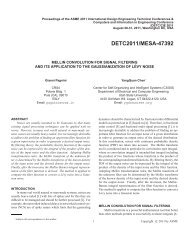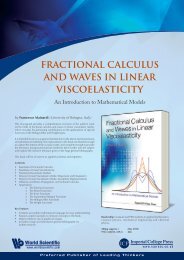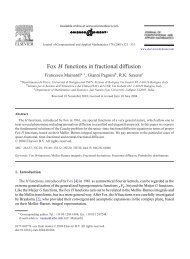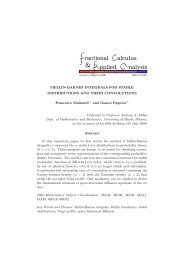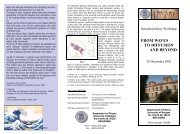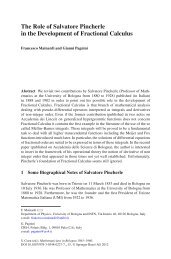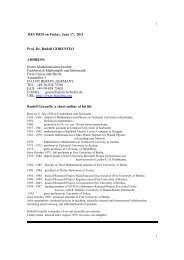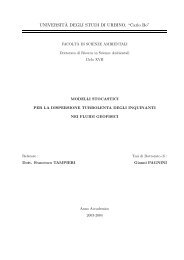CISM LECTURE NOTES International Centre for Mechanical Sciences
CISM LECTURE NOTES International Centre for Mechanical Sciences
CISM LECTURE NOTES International Centre for Mechanical Sciences
You also want an ePaper? Increase the reach of your titles
YUMPU automatically turns print PDFs into web optimized ePapers that Google loves.
280 Fractional Calculus: Some Numerical Methods<br />
For numerical treatment of fractional differential and integral equations it is<br />
essential to have available good approximations of the operators D α and J α of<br />
fractional differentiation and integration. So, in Section 2 we shall discuss the<br />
approach of Grünwald [10] and Letnikov [11] <strong>for</strong> approximation of D α by generalized<br />
finite differences, and in Section 3 we shall describe the basic ideas of discretized<br />
fractional calculus as it has been developed by Lubich [12]. In Section 4 we shall<br />
give a short survey on literature on product integration and collocation methods <strong>for</strong><br />
Abel type integral equations, and on the problem of ill-posedness of Abel integral<br />
equations of first kind. This ill-posedness causes specific troubles in many situations<br />
where a situation of evaluation of physical measurements is modeled by use of an<br />
Abel integral equation of first kind (see [5], [8] and [13] <strong>for</strong> examples).<br />
Throughout, our presentation will be in<strong>for</strong>mal, all occurring functions being<br />
assumed to be so regular that what is written down is meaningful. For precise<br />
conditions of required smoothness etc. and <strong>for</strong> rigorous proofs the reader is advised<br />
to look into the quoted references.<br />
2. GENERALIZED FINITE DIFFERENCES<br />
For derivation of approximations to the fractional differentiation operator D α it<br />
is convenient to make use of the discrete operators of translation (shift) and finite<br />
differences. In a lucid way the theory of numerical differentiation and integration<br />
(with equidistant grid points) is developed in Chapters 7 to 10 of [14]. See also<br />
Chapter 6 of [15].<br />
Let be τ ∈ IR . Then we define the shifting operator E τ and the (backward,<br />
<strong>for</strong>ward, central) difference operators ∇τ ,∆τ and δτ by their action on a function<br />
u(t) defined <strong>for</strong> t ∈ IR.<br />
⎧⎪<br />
E<br />
⎨<br />
⎪⎩<br />
τ u(t) =u(t + τ) ,<br />
∇τu(t) =u(t) − u(t − τ) ,<br />
∆τu(t) =u(t + τ) − u(t) ,<br />
δτ u(t) =u(t + τ/2) − u(t − τ/2) .<br />
Obviously, the operators E τ <strong>for</strong> τ ∈ IR have the group property,<br />
(2.1)<br />
E σ+τ = E σ E τ , σ ∈ IR, τ ∈ IR , (2.2)<br />
meaning E σ E τ u(t) =E σ u(t + τ) =u(t + τ + σ), and it is <strong>for</strong> this reason that in E τ<br />
we use τ as an exponent instead of as an index. We furthermore have the relations,<br />
with I as Identity operator,<br />
∇τ = I − E −τ , ∆τ = E τ − I, δτ = 1<br />
<br />
E<br />
2<br />
τ/2 − E −τ/2<br />
<br />
, (2.3)<br />
and all operators of this group commute with each other.



